Correction Queues Trip Up Maternity Benefit Applicants In Chhattisgarh
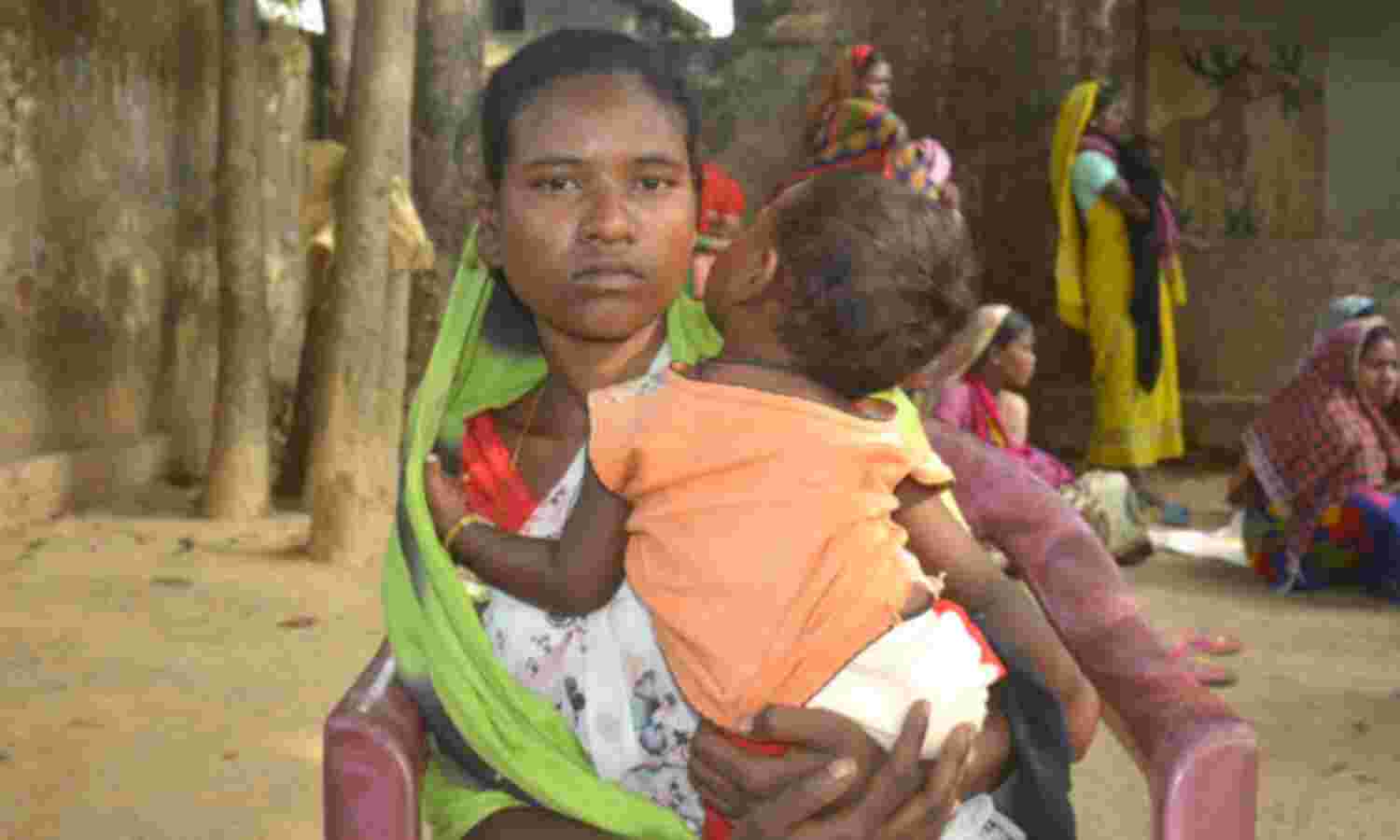
Ambikapur (Surguja district): “What should I do with a bank account when I never have any money in it?” Punita Palhe vented her frustration about not having received maternity benefits a year after having applied. She gave birth to a boy on July 5, 2018.
The 23-year-old and her husband eke out a living as daily wage labourers and growing paddy on the family’s one-acre farm in Rajpur block (a district sub-division) in Balrampur district in northern Chhattisgarh. The mineral-rich district is mostly inhabited by tribals, including members of the deprived Kodaku tribe, to which Palhe belongs.
Four months after giving birth, Palhe opened her first bank account in November 2018 in order to apply for benefits under the Pradhan Mantri Matru Vandana Yojana (PMMVY), a conditional cash transfer scheme for pregnant and lactating women introduced by the Ministry of Women and Child Development (MWCD) in 2017. Its beneficiaries are entitled to receive Rs 5,000 in three instalments.
Palhe is unaware of the bank in which she holds an account, but says she deposited Rs 750 as an initial opening amount. “Rajpur bus stand ke pass wala bank me khata khulwayi (I opened an account in the bank close to Rajpur bus stand),” she told IndiaSpend, referring to the Chhattisgarh Rajya Gramin Bank. Apart from a deduction of Rs 170 for annual debit card-ATM maintenance, there have been no transactions in her account--she has never used it.
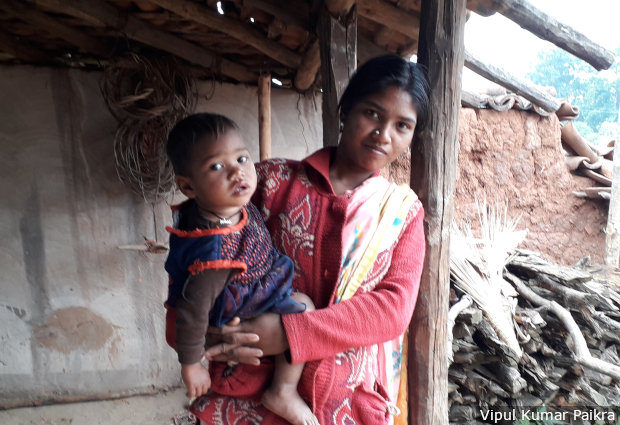
Punita Palhe and her son Priyanshu are members of the deprived Kodaku tribe from Rajpur in Chhattisgarh’s Balrampur district. The 23-year-old opened a bank account to apply for maternity benefits under the Centre’s conditional cash transfer scheme for pregnant and lactating women in November 2018. She had not received any money in her account until February 12, 2020.
The cash benefit she was hoping to receive under PMMVY has not materialised in her account in the last 15 months. The scheme’s guidelines stipulate a 30-day disbursement period for each of the three instalments.
Palhe is one of 565 mostly-uneducated women from six blocks in five Chhattisgarh districts who find themselves alienated as beneficiaries under a scheme that seeks to benefit them the most. The Chhattisgarh government has paid scant attention to an ever-increasing pile of pending applications under PMMVY even as it declared December 2-8, 2019, as maternity week to increase the enrollment of first-time nursing mothers under the scheme. This is an outcome of a fractured application process and a lack of redress mechanism, found members of Ambikapur-based non-government organisation Chaupal Gramin Vikas Prashikshan Evam Shodh Sansthan (Chaupal), which works in the domain of rights-based entitlements.
A complex form-filing and data-entry process, which is neither monitored nor cross-checked on the ground, and a weak feedback mechanism leads to many applications ending up in ‘correction queue’. For instance, 493 applications of the total 565 beneficiaries whose information Chaupal workers were able to find, i.e. 87.25% women, had not received any benefits because of typographical mistakes in their application forms. A majority of the typographical mistakes, nearly 73%, were related to applicants’ information as it appeared on their Aadhaar, including the Aadhaar information of their husbands (23.71%).
Chhattisgarh, a state with poor maternal, infant and child mortality rates, is thereby denying benefits to those in need due to an administrative quagmire. It was among the 10 states with a high neonatal mortality rate (NMR; newborn deaths in the first 28 days per 1,000 live births) of 26 in 2016. This is more than double the target NMR of 12 under the Sustainable Development Goals.
The state’s infant mortality rate (IMR; deaths of infants within 12 months of birth per 1,000 live births), was 38 in 2017. Its maternal mortality ratio (MMR; annual maternal deaths per 100,000 live births from any cause related to, or aggravated by pregnancy or its management) was 141, compared to 122 for India in 2015-17, significantly higher than the SDG target of 70 or less.
Maternity benefit schemes such as PMMVY can help partially remedy this situation. It recognises the link between child undernutrition and maternal health, and intends to provide a cash incentive for mothers to look after their health while partially compensating them for the wages lost while they rest and recuperate.
However, only 25% of mothers benefit from the scheme (‘benefit’ being described as having received at least one installment under PMMVY), as per a response to a Right to Information (RTI) query from the MWCD.
Chhattisgarh Chief Minister Bhupesh Baghel formed a seven-member committee on December 5, 2019, to assess whether maternity benefits should go beyond the Rs 5,000 provided under PMMVY for one child per family. He did so after Congress president Sonia Gandhi asked chief ministers in five Congress-ruled states to ensure maternity benefit of Rs 6,000 for all pregnant women in compliance with the National Food Security Act (NFSA). Chief Secretary R P Mandal chairs the committee, whose members include the state’s chief secretary of finance, principal secretary of panchayat and rural development, and secretaries of labour, health and family welfare, food, and women and child development departments.
Even as the committee mulls an increase in the maternity benefit amount, women like Palhe find themselves sinking money in bank accounts that they rarely operate and lose maintenance fees on. In an effort to understand why this has been the case, Chaupal members undertook the ‘Action week on maternity entitlement’ campaign during Chhattisgarh’s maternity week in December. The campaign was part of the larger Right to Food campaign organised by a country-wide network of social activists in the same week.
Chaupal field workers mobilised 145 applicants and beneficiaries from different villages in six blocks--Rajpur (Balrampur district), Bagicha (Jashpur district), Premnagar (Surajpur district), Bharatpur (Koriya district) and Lakhanpur and Lundra (Surguja district)--to help enroll them and clear pending applications. Most applicants, including some who had applied in 2017, had not received their maternity benefit while a few eventually found that their benefits had been credited in bank accounts they no longer operated.
Chaupal workers and the applicants/beneficiaries visited their respective Child Development Project Officer (CDPO), under the state’s women and child development department, to submit a memorandum about not receiving their maternity entitlement. Chaupal workers also submitted an application asking for names of all those whose applications had been deemed to be correct, or had been rejected.
The scheme and the process
A woman can apply to become a PMMVY beneficiary within 730 days (roughly two years) of the date of her last menstrual period (LMP). In the absence of information on LMP, she must apply within 460 days from the date of childbirth. Prior to that, it is mandatory for a woman to register herself within 150 days (about five months) from her LMP date at the local anganwadi centre (AWC) to get a ‘Mother and Child Protection Card’ (MCPC).
The PMMVY benefit of Rs 5,000 is disbursed in three instalments: Rs 1,000 after registration for MCPC, Rs 2,000 after at least one antenatal check-up, and the final Rs 2,000 after the birth and vaccination of the child. Applicants have to fill a different form (four-page 1A form for the first installment, three-page 1B form for the second and another three-page 1C form for the third) each time they want to avail of the installment.
The forms are provided at AWCs for free. In Chhattisgarh, these forms have been translated into Hindi. Nevertheless, women find it difficult to fill them--rural female literacy in the state is 55.06%, according to Census 2011. Applicants often pay someone else to fill their form, found Chaupal workers.
These forms have to be submitted with several copies of documents, including the applicant’s MCPC, Aadhaar of the applicant and her husband, bank passbook, and the child’s birth certificate for the third instalment (Table 1). Providing documents is another uphill task: Opening a bank account is not always easy for women and nor is linking it with Aadhaar. Applicants told Chaupal members that they have often had to shell out upto Rs 700 to open a bank account and Rs 200 to have an Aadhaar generated.
| Process & Documentation For Three Instalments Of PMMVY | |||
|---|---|---|---|
| Instalment | Conditions | Documents Required | Amount |
| First Instalment | Requires mother to:
|
| Rs 1,000 |
| Second Instalment |
|
| Rs 2,000 |
| Third Instalment |
|
| Rs 2,000 |
*Scheme guidelines state ID proof, but only Aadhaar is accepted as identity proof.
Source: Scheme conditions
The application forms and copies of supporting documents are submitted at the AWC. A field supervisor, a government official under the state’s women and child development department, collects these forms and documents from the AWC; one field supervisor is assigned to each block in a district, each block has 25-35 AWCs. The supervisor takes the applications to data-entry operators (DEO) in the block office, who then feed the information from the paper forms into the scheme’s Common Application Software (PMMVY-CAS).
This is the stage where discrepancies about the applicants’ information are most likely to enter the system, and remain uncorrected, according to anecdotal information from data entry operators and Chaupal workers.
After the data entry, the CDPO, who is also the sanctioning officer (SO), either ‘approves’, ‘rejects’ or ‘corrects’ an application on the PMMVY-CAS. If rejected, an applicant is no longer eligible for that installment; applications are rejected primarily because the woman would be ineligible for the benefits.
If approved, the application automatically goes for verification by Unique Identification Authority of India (UIDAI) and Public Financial Management System (PFMS; a platform for e-payment of subsidies and benefits under Direct Benefits Transfer to Aadhaar-linked and non-Aadhaar-linked bank accounts). If verified, the nodal officer at the state’s ministry of women and child development gives the final approval for disbursement. The money is then supposed to be deposited into the beneficiary’s bank account through PFMS gateway within 30 days, as per the scheme’s guidelines. The time taken to disburse the money varies in each block and district, Chaupal workers found. For example, in Surguja district, the average time taken to complete the process has been 111 days since the scheme started, according to the PMMVY-CAS dashboard.
The ‘correction’ queue
An application may fail UIDAI or PFMS verification after the sanctioning officer’s approval. The PFMS verification may be declined if the applicant’s name in bank records does not match the PFMS database, or if her account has become inactive or dormant for lack of transaction activity. A UIDAI verification may fail due to typographical mistakes in the details of the beneficiary or her husband. Failures also happen when a beneficiary’s Aadhaar lists her address as that of her maternal home and not that of her current/in-laws’ residence.
If either the UIDAI or PFMS verifications fail, then the application lands in the ‘correction queue’ where the reason for rejection and required corrective action to be taken are mentioned. When an application ends up in the correction queue, then the field supervisor and anganwadi worker relay the information to the applicant so that the required corrections can be made and submitted for approval again.
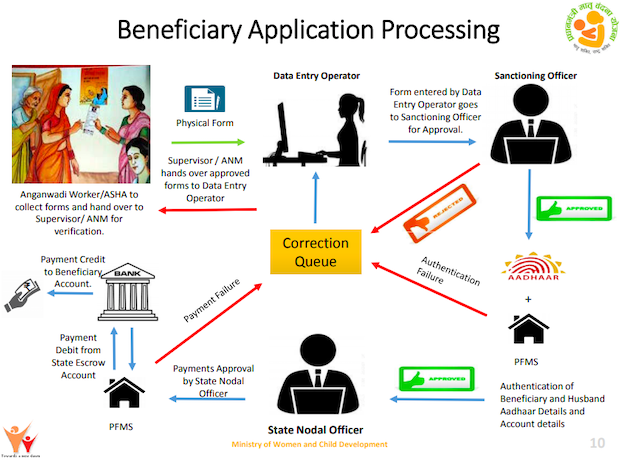
Source: Ministry of Women & Child Development
A pictorial representation of the different stages in the process to access benefits under the Pradhan Mantri Matru Vandana Yojana.
This information-relaying process is critical because a failure in informing the applicant can mean that her application stays in the correction queue in the scheme’s software for months. There is no foolproof mechanism in place to check whether information about an application in the correction queue has indeed been relayed to the applicant, as Chaupal workers found out during their campaign.
Field supervisors and anganwadi workers can turn out to be unreliable. For instance, anganwadi worker Tara Netam told Chaupal workers that she could not remember the eligibility time period for potential applicants even though she recalls being told about the same. Two mothers whose forms she filled five months after the delivery of their respective children in Thadsukhpara village under Rajpur block in July 2019 were yet to receive their benefit as of January 2020, Netam said. The 35-year-old did not know if their applications were approved, rejected or in the correction queue.
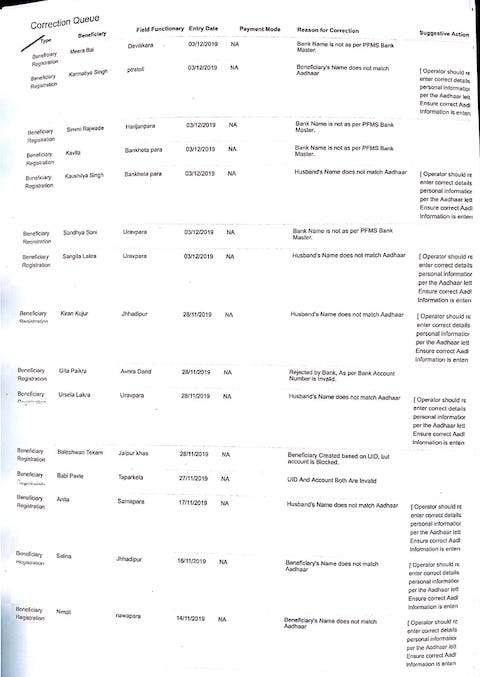
A correction queue from Lakhanpur block in Surguja district. Credit: Vipul Kumar Paikra
Ground reality
The extent of how problematic the ‘correction queue’ can be was apparent when Chaupal researchers were in Lakhanpur, a tehsil (sub-district) of about 120,000 residents. Nearly 90 of 104 applications at the Lakhanpur CDPO office were in the correction queue for typographical mistakes, said data entry operator Ram Kumar (Table 2). “A spelling mistake or a dot after the name or even an extra space can take the application to the correction queue,” the 30-year-old said. “Ideally, when we seed the Aadhaar of a beneficiary, the system should automatically fill the person’s name and other details from the Aadhaar database. Why does this not happen?”
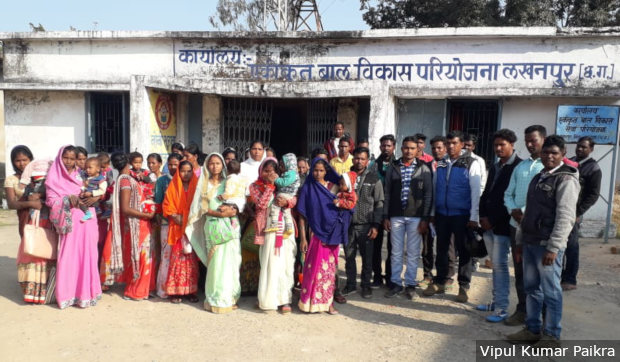
Aggrieved PMMVY applicants outside the Child Development Project Officer’s office in Lakhanpur in Surguja district in northern Chhattisgarh, in December 2019.
Kumar’s observation about typographical errors is borne out by data that Chaupal workers obtained from CDPO offices in six blocks during their campaign. Most applications end up in the correction queue because of a mismatch in the name as it appears in Aadhaar or is not as per PFMS master list (Table 2). The other reasons applications end up for corrections are related to banking--either the account numbers are invalid or bank information (name or IFSC code) is inaccurate.
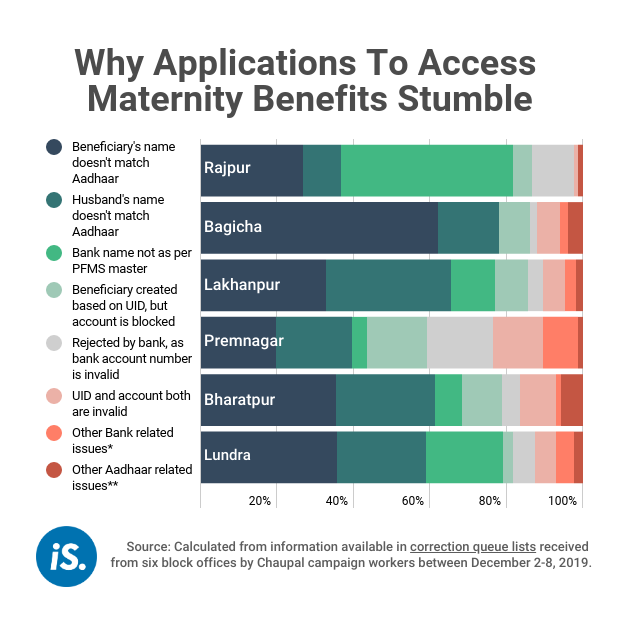
*Includes reasons such as ‘invalid bank/post office name’, ‘No such account’, ‘Account blocked or frozen,’ etc. **Includes reasons such as ‘Husband's Aadhaar is suspended’, ‘UID is invalid and account is rejected due to no response received from bank’, ‘Beneficiary's Aadhaar is suspended’ and so on.
When applications end up for corrections, the software throws up suggestions for how the errors can be rectified. Many of these, especially typographical ones, can be fixed by the data operator, who can summon the applicant by intimating the field supervisor to alert the applicant to get the correct information.
This chain of information often breaks down when it reaches the anganwadi worker, Chaupal workers found. “The field supervisor reads out the name and reason for correction queue of beneficiaries at periodic meetings of anganwadi workers. We often fail to take notes on paper when the announcements are being made,” Netam, the anganwadi worker from Rajpur, told IndiaSpend. “We in turn fail to convey this to the applicant, or fail to obtain the requisite information from them.”
Additionally, the PMMVY-CAS does not provide any suggestions or corrective action to be taken for other reasons listed on correction queue, including ‘Bank name is not as per PFMS master’ or ‘Aadhaar suspended/invalid/cancelled’. In such cases, data entry operators ask the applicants/beneficiaries to get their Aadhaar or bank account ‘activated’.
Registration for PMMVY and the correction queue in effect becomes an entry barrier for applicants. A majority, or 96.63% of the 565 beneficiaries whose information the Chaupal workers were able to find during the campaign, had not received PMMVY benefits because their application did not go beyond the registration level (Table 3). The data for Rajpur and Bharatpur blocks indicate that none of the women who had applied, some as far back as in 2017, had gone past the ‘correction queue’ process to receive benefits.
Once this hurdle is cleared, few applications remain pending for corrections for first, second and third installments. These relate mostly to banking issues such as frozen bank accounts or pending KYC.

In some cases where beneficiaries claimed they had not received benefits in their bank accounts, Chaupal workers eventually found that some of them had received money in bank accounts they no longer operated. Several such beneficiaries in Karwa village, in Balrampur district’s Rajpur block, told Chaupal workers that they did not know for months that installments had been credited because they no longer operated those accounts, especially the ones they were made to open under the Pradhan Mantri Jan Dhan Yojana, because the CDPO, field supervisor or anganwadi worker had not informed them.
If a person has more than one bank account, and all the accounts are linked with the individual’s Aadhaar, then the maternity installment is automatically credited into the account that is last linked to Aadhaar.
Exclusion, and how to fix it
When teenage mother Chainti Edege wanted to apply for maternity benefits under PMMVY after giving birth to a boy on June 28, 2019, the anganwadi worker in Karwa village told her that she would not be able to do so because she would mandatorily have to submit her son’s father’s Aadhaar along with her own.
The 19-year-old, a member of the Pahari Korwa tribe (a particularly vulnerable tribal group, or PVTG), had gotten pregnant without getting married. Her partner belongs to a different tribe, and refused to accept Edege when she got pregnant, or his son.
Edege lives in her maternal home with her son, and has access to rations thanks to her mother’s ration card, which lists her name. She prefers to work as a daily wage labourer to avoid having to ask her family for money. “I would have purchased rice for myself and my child if I had received the PMMVY money,” she told IndiaSpend.
Her experience demonstrates that the mandatory requirement of the husband’s documents for maternity benefits can alienate single mothers. Doing away with this criteria would also help married applicants given that a large number of applications get stuck because of a mismatch in the information on the husband’s Aadhaar.
The PMMVY scheme can be far more inclusive if all mothers, irrespective of their age and marital status, are made eligible, according to Surguja’s district programme officer, Jyoti Minj. “Child marriage is prevalent in tribal areas such as Surguja, and a lot of underage mothers get excluded because of the eligibility criteria.”
“Dropping the husband’s Aadhaar as a mandatory document, allowing identity proofs other than Aadhaar and more user-friendly application forms would greatly simplify the registration process,” Rajpur social activist Kirani Ekka told IndiaSpend. “The [PMMVY] scheme can make a difference in the lives of a much larger number of women if benefits are extended to all births.”
Ekka also pointed out that PMMVY lacks transparency as there is no website or interface for public information as exists for other government programmes such as the rural employment guarantee scheme and the public distribution system.
The scheme could even provide economic independence to women who cannot earn for themselves if benefits are enhanced well above the current Rs 5,000, Ekka added. A majority of the 2,700 beneficiaries of PMMVY’s predecessor scheme, the Indira Gandhi Matritva Sahyog Yojana, in 15 states, desired a cash benefit of Rs 11,000, according to an April 2017 Niti Aayog survey. “This [enhanced amount] would help women not only access food and medicine, but gain respect too,” 31-year-old Ekka said.
(Paikra works in Surguja with Chaupal Gramin Vikas Prashikshan Evam Shodh Sansthan. He was one of the field workers for the campaign. He would like to thank Jean Drèze, Advaita Rajendra and Anmol Somanchi for their inputs. Editing by Marisha Karwa)
We welcome feedback. Please write to respond@indiaspend.org. We reserve the right to edit responses for language and grammar.


